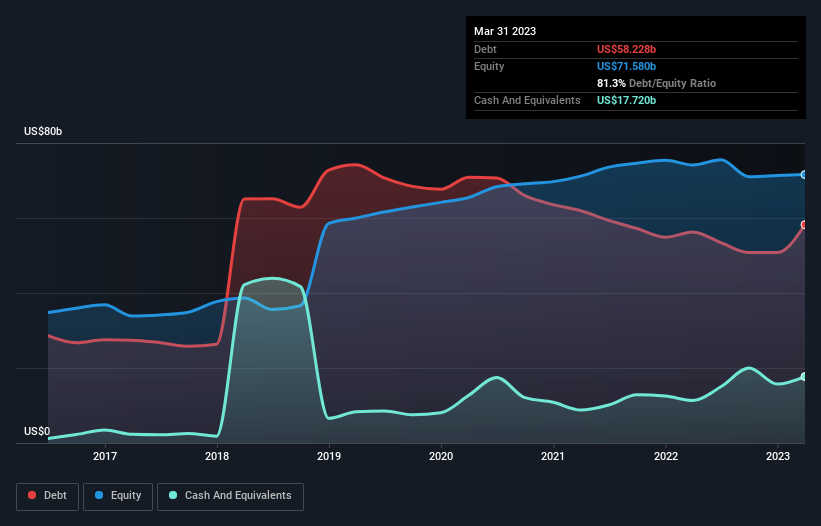Legendary fund manager Li Lu (who Charlie Munger backed) once said, ‘The biggest investment risk is not the volatility of prices, but whether you will suffer a permanent loss of capital.’ When we think about how risky a company is, we always like to look at its use of debt, since debt overload can lead to ruin. importantly, CVS Health Corporation (NYSE:CVS) does carry debt. But is this debt a concern to shareholders?
What Risk Does Debt Bring?
Debt is a tool to help businesses grow, but if a business is incapable of paying off its lenders, then it exists at their mercy. Ultimately, if the company can’t fulfill its legal obligations to repay debts, shareholders can walk away with nothing. However, a more common (but still painful) scenario is that it has to raise new equity capital at a low price, thus permanently diluting shareholders. Of course, plenty of companies use debt to fund growth, without any negative consequences. When we think about a company’s use of debt, we first look at cash and debt together.
See our latest analysis for CVS Health
What Is CVS Health’s Net Debt?
As you can see below, CVS Health had US$58.2b of debt, at March 2023, which is about the same as the year before. You can click the chart for greater detail. However, it does have US$17.7b in cash offsetting this, leading to net debt of about US$40.5b.

How Healthy Is CVS Health’s Balance Sheet?
Zooming in on the latest balance sheet data, we can see that CVS Health had liabilities of US$75.1b due within 12 months and liabilities of US$92.7b due beyond that. Offsetting this, it had US$17.7b in cash and US$28.3b in receivables that were due within 12 months. So its liabilities outweigh the sum of its cash and (near-term) receivables by US$121.7b.
When you consider that this deficiency exceeds the company’s huge US$88.3b market capitalization, you might well be inclined to review the balance sheet intently. Hypothetically, extremely heavy dilution would be required if the company were forced to pay down its liabilities by raising capital at the current share price.
We measure a company’s debt load relative to its earnings power by looking at its net debt divided by its earnings before interest, tax, depreciation, and amortization (EBITDA) and by calculating how easily its earnings before interest and tax (EBIT) cover its interest expenses (interest cover). The advantage of this approach is that we take into account both the absolute quantum of debt (with net debt to EBITDA) and the actual interest expenses associated with that debt (with its interest cover ratio).
We’d say that CVS Health’s moderate net debt to EBITDA ratio (being 2.1), indicates prudence when it comes to debt. And its commanding EBIT of 11.6 times its interest expense, implying the debt load is as light as a peacock feather. We saw CVS Health grow its EBIT by 2.4% in the last twelve months. That’s far from incredible but it’s a good thing, when it comes to paying off debt. There’s no doubt that we learn most about debt from the balance sheet. But ultimately the future profitability of the business will decide if CVS Health can strengthen its balance sheet over time. So if you’re focused on the future you can check out this free report showing analyst profit forecasts.
Finally, a business needs free cash flow to pay off debt; accounting profits just don’t cut it. So the logical step is to look at the proportion of EBIT that is matched by actual free cash flow. Happily for any shareholders, CVS Health actually produced more free cash flow than EBIT over the last three years. That kind of strong cash generation warms our hearts like a puppy in a bumblebee suit.
OurView
CVS Health’s conversion of EBIT to free cash flow was a real positive on this analysis, as was its interest cover. But truth be told its level of total liabilities had us nibbling our nails. We would also note that Healthcare industry companies like CVS Health commonly use debt without problems. When we consider all the factors mentioned above, we do feel a bit cautious about CVS Health’s use of debt. While debt does have its upside in higher potential returns, we think shareholders should definitely consider how debt levels might make the stock more risky. There’s no doubt that we learn most about debt from the balance sheet. However, not all investment risk resides within the balance sheet – far from it. Case in point: We’ve spotted 3 warning signs for CVS Health you should be aware of.
If, after all that, you’re more interested in a fast growing company with a rock-solid balance sheet, then check out our list of net cash growth stocks without delay.
What are the risks and opportunities for CVSHealth?
CVS Health Corporation provides health services in the United States.
View Full Analysis
Rewards
-
Trading at 58% below our estimate of its fair value
-
Earnings are forecast to grow 9.94% per year
risks
-
Profit margins (1.2%) are lower than last year (2.7%)
-
Large one-off items impacting financial results
-
Has a high level of debt
View all Risks and Rewards
Have feedback on this article? Concerned about the content? get in touch with us directly. Alternatively, email editorial-team (at) simplywallst.com.
This article by Simply Wall St is general in nature. We provide commentary based on historical data and analyst forecasts only using an unbiased methodology and our articles are not intended to be financial advice. It does not constitute a recommendation to buy or sell any stock, and does not take account of your objectives or your financial situation. We aim to bring you long-term focused analysis driven by fundamental data. Note that our analysis may not factor in the latest price-sensitive company announcements or qualitative material. Simply Wall St has no position in any stocks mentioned.
